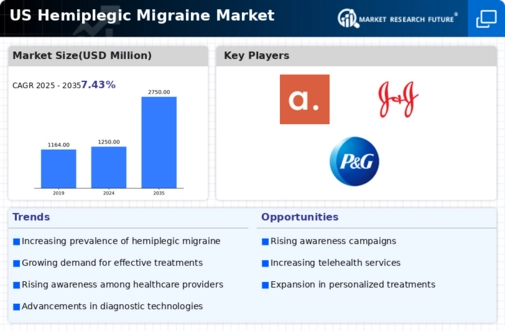Growing Research and Clinical Trials
The hemiplegic migraine market is benefiting from a surge in research and clinical trials focused on this condition. Increased funding from both public and private sectors has led to a greater understanding of hemiplegic migraines, which is crucial for developing effective treatments. As of November 2025, numerous clinical trials are underway, exploring various therapeutic approaches, including preventive treatments and acute management strategies. This research activity not only enhances the knowledge base but also fosters collaboration among researchers, healthcare providers, and pharmaceutical companies. The hemiplegic migraine market is thus poised for growth as new findings translate into clinical practice.
Rising Incidence of Hemiplegic Migraine
The hemiplegic migraine market is experiencing growth due to an increasing incidence of hemiplegic migraines in the US. Recent studies indicate that the prevalence of this rare type of migraine is approximately 0.1% of the population, which translates to around 300,000 individuals affected. This rising incidence is prompting healthcare providers to enhance their diagnostic capabilities and treatment options, thereby expanding the market. As awareness grows, more patients are likely to seek medical attention, leading to increased demand for specialized treatments. The hemiplegic migraine market is thus positioned for growth as healthcare systems adapt to meet the needs of this specific patient population.
Innovations in Pharmaceutical Treatments
The hemiplegic migraine market is significantly influenced by innovations in pharmaceutical treatments. Recent advancements in drug development, including the introduction of targeted therapies and biologics, have shown promise in managing hemiplegic migraines. For instance, the FDA has approved several new medications that specifically address the unique pathophysiology of hemiplegic migraines. This innovation is expected to drive market growth, as patients gain access to more effective treatment options. The hemiplegic migraine market is likely to see an increase in investment from pharmaceutical companies aiming to develop novel therapies, which could enhance patient outcomes and expand market reach.
Increased Insurance Coverage for Treatments
The hemiplegic migraine market is experiencing a shift due to increased insurance coverage for treatments. As awareness of hemiplegic migraines grows, insurance providers are beginning to recognize the need for comprehensive coverage of specialized therapies. This trend is particularly relevant in the US, where patients often face high out-of-pocket costs for migraine treatments. Enhanced insurance policies that include coverage for newer medications and therapies are likely to improve patient access to necessary treatments. Consequently, the hemiplegic migraine market stands to benefit from this development, as more patients will be able to afford and seek effective care.
Enhanced Patient Education and Support Programs
The hemiplegic migraine market is positively impacted by enhanced patient education and support programs. Organizations dedicated to migraine awareness are increasingly providing resources that educate patients about hemiplegic migraines, their symptoms, and available treatments. This educational outreach is crucial, as it empowers patients to seek timely medical intervention, which can lead to better management of their condition. Furthermore, support programs that connect patients with healthcare professionals and peer networks are emerging, fostering a sense of community. The hemiplegic migraine market is likely to benefit from this trend, as informed patients are more likely to engage with healthcare systems and adhere to treatment regimens.














Leave a Comment